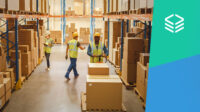
Pre-2020, the popularity of ecommerce was already trending up, with more shoppers buying from digital platforms year over year. The pandemic further accelerated consumers’ need to shop online for everything from groceries to home goods, solidifying ecommerce as the primary mode of purchase for many. This surge has led brands to realign their sales strategies to keep up with technology trends in ecommerce that will keep them competitive in the months and years to come.
What are the trends shaping ecommerce in 2022?
There are several areas of focus shaping the future of ecommerce technology. Here are a few of the top ecommerce technology trends companies should keep top of mind and incorporate into their own ecommerce business models.
1. Omnichannel integration
Brands must sell where customers are shopping, which often means meeting them across multiple devices and channels before a purchase is made. This ecommerce trend is known as omnichannel integration. Consumers expect a personalized omnichannel experience that speaks to their online shopping preferences. Implementing technology to track customer behavior and product popularity can help curate the experience they’re looking for as they search online.
2. Social commerce
One of the fastest-growing ecommerce technology trends combines social media and commerce. Social commerce sales in the U.S. are expected to reach nearly $80 billion in 2025, up from $27 billion reported in 2020. Instagram and Facebook already attract billions of users every month, with TikTok quickly gaining speed. All three apps offer social shopping experiences, which are gaining popularity every day, including augmented reality and artificial intelligence-enabled formats. Connecting ecommerce stores with social media channels has become the driving force behind online sales by allowing consumers to shop straight from their feed with a single click.
3. Adoption of digital supply chain tech
Real-time visibility streamlines the complexity of traditional supply chains. This technology trend involving supply chain allows businesses to make data-driven decisions for sourcing materials and products they need to meet fluctuating customer demand. Owing to forecasting capabilities with this digital commerce trend, companies can better predict and plan, which leads to improved customer satisfaction through fast, on-time delivery.
4. Sustainability
Consumers are making buying decisions based on how well brands reflect their own values. The sustainability ecommerce trend continues to be a top priority for ecommerce shoppers, with one survey reflecting 67% of respondents considering the use of sustainable materials an important factor when purchasing products. This includes how a product is made as well as how it’s transported. Through network optimization, Flowspace fulfillment centers are chosen based on proximity to customers and can reduce transportation-related emissions by 75% or more.
How can ecommerce businesses leverage technology to streamline and improve the buyer’s journey?
Consumers expect their purchasing experiences to be seamless and convenient. Ecommerce companies can answer this call through integrated fulfillment technology that simultaneously streamlines the buying process and creates an optimal customer journey. It delivers:
Real-time visibility and communication
Leveraging ecommerce fulfillment technology to sync up information from all sales channels results in a better customer experience. Ecommerce shoppers want fast, free delivery, and want to be able to track the progress of their deliveries. To avoid frustrations and delays, ecommerce businesses must be proactive in their communication. Technologies like mobile messaging, live chat, and chatbots provide instantaneous alerts and answers for customers throughout the entire post-purchase process.
Optimized inventory allocation
An interconnected technology platform allows businesses to track and forecast inventory management trends to prevent stockouts or overflows. Additionally, using an algorithm to find the optimal order fulfillment center from a widely distributed network puts products closest to customers. This speeds up shipping times, reduces costs, and improves overall customer satisfaction.
Convenient one-click checkout
Mobile wallet is the future of ecommerce technology. Online shoppers expect and benefit from the convenience and security of a one-click checkout. Integrating the functionality of contactless payments has become an essential feature, with many brands launching mobile apps to support one of the most important technology trends in ecommerce.
Advanced customization
Customer insights play a significant role when creating highly personal experiences and encouraging brand loyalty. Using AI and automation tools to predict product trends, buying habits, and other valuable insights helps ecommerce businesses optimize the entire supply chain and deliver premium customer service.
Central platform integration
Omnichannel integration allows all shopping carts, marketplaces, and retail stores to be synced up in one place. Customers can stay on the ecommerce platform where they’re online shopping and enjoy a one-click checkout that’s convenient and immediate. Meanwhile, ecommerce businesses benefit from real-time recommendations to optimize the entire supply chain.
How can ecommerce retailers prepare their ecommerce fulfillment operations to meet these demands?
Utilizing the Flowspace platform
Ecommerce technology trends are driven by customer expectations. What today’s consumer wants is personalization during their shopping experience―for businesses to meet them where they are in a way that aligns with their values, lifestyles, and shopping preferences. Utilizing the trends mentioned above will only help drive you to ecommerce success. Flowspace gathers customer insights to observe buying behaviors and product trends, which allows ecommerce businesses to make informed decisions that will meet and exceed customers’ expectations every step of the way.
Additionally, the Flowspace platform centralizes ecommerce order fulfillment operations through a user-friendly interface. This allows ecommerce businesses to connect all partners, sales channels, systems, and tools in one central place, offering visibility and control over inventory management, customer insights, and other helpful data to create a seamless experience. Brands that embrace the future of ecommerce technology are the ones that’ll continue to grow by uncovering new, innovative business opportunities as a result.
Ready to learn more about how Flowspace can help your brand tap into technology trends?
Sources:
- Statista. Social commerce sales in the United States from 2020 to 2025. https://www.statista.com/statistics/277045/us-social-commerce-revenue-forecast/
- Netsuite. Digital Supply Chain Explained. https://www.netsuite.com/portal/resource/articles/erp/digital-supply-chain.shtml
- McKinsey & Co. Survey: Consumer sentiment on sustainability in fashion. https://www.mckinsey.com/industries/retail/our-insights/survey-consumer-sentiment-on-sustainability-in-fashion






